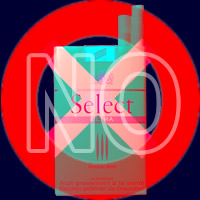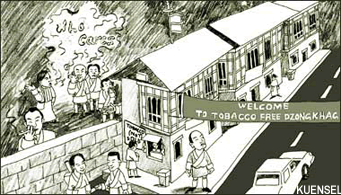|
Bhutan
Country Information
|
 |
Bhutan Information |
|
 |
Bhutan Information |
|
|
 |
|
2001: Tobacco-free initiative: where does Bhutan stand?
|
|
Every day, at about 9.00 am and again at about 5.00 pm, four boys, ages ranging from 9-13 years, visit a small pan shop in the part of Thimphu known locally as Hong Kong market to buy a cigarette and a bun each. They light their cigarettes, eat the buns and disperse, chatting loudly among themselves.
The four boys, who pick scrap for a living, said that smoking makes them "feel good and happy". Three of them are sons of Indian migrant workers. One is a Bhutanese."It is really disturbing to see children destroy themselves like this," a concerned onlooker said. A few kilometres up the road, Bhutan was hosting the WHO-SEARO intercountry consultation on the Framework Convention on Tobacco Control.
|

|
Bhutan has so far received seven medals of commendation and recognition for initiatives taken to control tobacco. Eighteen out of the 20 dzongkhags have been declared "tobacco free" and the sale of tobacco and tobacco products banned.
In fact, Bhutan is known to be one of the first countries in the world to have passed a tobacco control law, as early as 1729, by Zhabdrung Ngawang Namgyal. Religious institutions like dzongs have since been tobacco free.
Foreign journalists have commented on the success of Bhutan's anti tobacco campaigns. "Even Thailand is a Buddhist country but we have not been able to relate religion with smoking," said Mukdawan Sakboon, a reporter from The Nation in Bangkok. "I find it impressive that religion has been used to the advantage of public health."
Another journalist from Bangladesh told Kuensel that he was amazed by the effective "fusion of religious belief and health care consciousness". "I think this helped the anti-tobacco campaign in Bhutan move forward successfully," he said.
 |
|
A recent impact assessment carried out by the IECH revealed only one percent smoking rate among a survey population of 1035.
But, despite all these commendations, tobacco is very much an issue for discussion. "I think there are more young people smoking today than ever before," one "mild smoker" said.
Another smoker pointed out that there was no dearth of cigarettes in the country. "I can buy a packet of cigarette any time anywhere," he said.
|
|
"There is a vibrant and lucrative under-the-counter tobacco trade in nearly all the tobacco free dzongkhags," said a government official in Thimphu who frequently travels around the country.
Revenue and Customs officials acknowledge that there is "an uncontrollable" illicit trade in tobacco products. "Over 90 percent of the tobacco products are smuggled into the country," said the joint director of the customs and excise division, Zamtsho Tshering.
The trade statistics for tobacco products, maintained by revenue and customs department, are not credible. The national import value of all tobacco products from India for the whole of 1999 is reported to be Nu. 114,025. Customs officials themselves agree that this is a ridiculous figure considering that over 80 percent of all tobacco imports come from India.
Samdrup Jongkhar, which is the sole entry point of tobacco products for the entire eastern dzongkhags reported an import of just 77 kilograms of tobacco products, worth Nu. 5,548 in 2000. This figure is actually a compilation of records from the four checkpoints in Daifam, Nganglam, Bangtar, and Samdrup Jongkhar. The checkpoint in Samdrup Jongkhar itself reported the entry of just three kilograms of tobacco products for the entire year.
"We do organise frequent and surprise inspections at all our check points but people manage to smuggle it in," said Zamtsho Tshering who added that government and light private vehicles, which either do not require inspection or are subjected to only a casual inspection, are responsible for smuggling tobacco products into the country.
Meanwhile the duty free shop in Thimphu sold more than Nu. 6.4 million worth of cigarettes, imported from third countries in 1999.
A major supplier of unrecorded tobacco products is believed to be the IMTRAT and DANTAK canteens. "I would think that they sell the maximum," a customs official saidl. "Most of our shopkeepers buy from them."
Dealers in the dzongkhags get their supplies from Thimphu, which is not a tobacco free dzongkhag. "Shops and smokers in the dzongkhags get their supply from friends, relatives, acquaintances, and dealers in Thimphu," said one smoker.
Health officials, however, maintain that the fight against tobacco has been a success.
"We recently undertook a thorough and extensive review of the central dzongkhags and found out that tobacco control has been very effective," health spokesman, Dr. Rinchen Chophel, said.
"We are aware that the demand for cigarettes in certain parts of the country are met by a floating population but, because of the high cost, it stays out of the reach of many people." "In any case we cannot ban individuals from smoking," Dr. Rinchen added. "We can only equip people with the knowledge that tobacco is harmful. It has to be an informed choice."
Dr. Rinchen Chophel said that a national "tobacco and alcohol free initiative programme", with realistic objectives, strategies, and milestones had now been instituted. A 'high-powered national multi-sectoral task force on tobacco and alcohol' was also in place.
In addition, a tobacco prevalence survey, based on WHO standards but altered to suit Bhutan's needs, was presently being conducted in the country. "Once this survey is completed, we should have a clearer perspective of the tobacco situation in the country," Dr. Rinchen Chophelsaid.

|
| Contributed by KUENSEL, Bhutan's National Newspaper, November 2001 |
| Information on Bhutan |
 |
|




